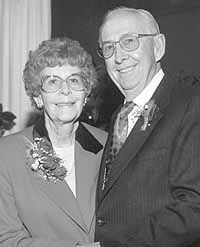| Margaret and George Conover |
Margaret
My first recollection of a cancer patient was my grandmother Mary Ann Snow Moffitt in that she suffered from an incurable disease and that there was no chance of her recovering from it. Her cancer was in her throat and the final stages of the cancer were almost unbearable, and very disturbing to a young girl, knowing there was no treatment or cure available at that time. She died in 1931.
Having said that, it is no wonder that I grew up with a fear and dread of the disease. My personal experience with cancer came at the age of 68. For several years before, I had been very faithful in getting the yearly exams recommended by my doctor, and was also on hormone replacement therapy. My husband George and I were on our third full time mission for our church in Palmyra, N.Y. in 1989. I had passed my physical exam in March, but in November I started having problems, and being far from home, was not in the care of my doctor. Finding a doctor is another story, but we were finally led to Dr. Thomas Pulvino, a wonderful, highly trained doctor in Newark, N.Y., 30 miles north of Palmyra. He diagnosed uterine cancer, and did surgery the next day, on Nov. 16, 1989. I had immediate confidence in the doctor, and was surprisingly calm and not afraid when he told me I had cancer.
Dr. Pulvino advised us to stay in Palmyra for at least six weeks for me to heal, and then to have the radiation treatment at another hospital in Clifton Springs, N.Y. I had one mega-treatment (43 hours) of radiation on Dec. 21-22. George was able to continue his missionary duties at the Grandin Building as a tour guide during those six weeks.
We started driving home on Dec. 27, taking five days. I haven’t had any reoccurrence of that cancer since. Radiation side-effects were extreme fatigue and lowered immune system. I still have the yearly exams.
Four years later, in January 1994, after a routine mammogram, a suspicious spot showed up in the right breast, and the doctor recommended a needle biopsy. The lump was very small, but tested positive for malignancy. The doctor consulted with family and myself and did a lumpectomy and also some lymph-node surgery. They were clean so no further surgery was done at that time. In February 1994, I started radiation therapy at the Provo Oncology Clinic, five times a week for eight weeks, a check up every three months for a year, every six months for another year, then once a year for three more years. I continued with the yearly mammograms, and on June 18, 2002, had a large lump removed, and another one in March of 2004, but neither one showed any cancer.
Early detection, following through on treatments available, and scheduled check ups-along with a positive attitude coupled with faith, prayer and support from family and friends-give us this “Life after Cancer.”
Thanks to good doctors, health personnel, volunteers, and those who work hard to bring us “Relay for Life.”
George
In the spring of 1990, in a routine physical examination for a previous heart problems, the doctor advised me, at the age of 73, to have a PSA blood test to detect a possible prostate problem. As a result of my visit to the urologist, the PSA blood test came back much too high, which indicated a possible serious problem in the future. The doctor repeated the blood test periodically for two years, and it continued to go up, so he scheduled an ultrasound, but nothing showed up. After several months, the doctor did a biopsy. Nothing showed up but the count kept climbing.
Then in the fall of 1995, another biopsy confirmed a small cancer. The doctor said it was like looking for a needle in a haystack, but because of the high PSA test and the doctor’s concern, he kept looking. He scheduled me for radiation therapy at the Provo Oncology Clinic, and I began the treatments in October 1995, five days a week for eight weeks. We took a camp trailer to stay close to the hospital, came home to Ferron on Friday and back to Provo on Monday. There were some specific rules I was to follow before each treatment, and by being extra conscientious about following them, I had no adverse reactions from the radiation, only some fatigue that seems to happen to everyone who takes it. Before the treatments my PSA count was over 40, and it went to 0.1 where it still remains.
Thanks to good doctors and treatments available, and to all volunteers-whoever they may be-may we all work together to “stamp out cancer.”

